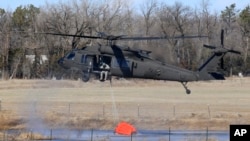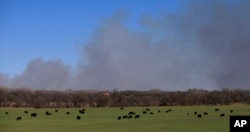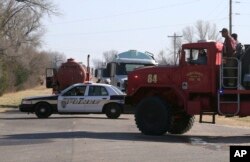The winds fueling deadly wildfires that scorched vast swathes of land in four Plains states finally dropped Thursday, bringing hope to crews trying to contain the blazes. Emergency personnel warned, however, that extremely dry conditions and hot spots could cause a flare-up, even in areas where there's "not much left to burn."
Most of the burned land is in Kansas, where about 2,000 firefighters have been battling a series of blazes that consumed more than 1,000 square miles and damaged or destroyed dozens of structures. The firefight Thursday was focused on four counties, down from 21 on Monday.
One blaze, encompassing two counties along Kansas' southern border with Oklahoma, is the largest wildfire on record in Kansas. Emergency officials said Thursday that crews are monitoring hot spots after the fire was 70 percent contained in Comanche County and 50 percent in Clark County.
Monitoring is crucial because the ground is "extremely dry," and it was possible that sparks from a smoldering stump could re-ignite the fire, said John Lehman, the emergency manager in Comanche County, where 234 square miles has burned.
By midafternoon Wednesday, Lehman said firefighting efforts were calming in his county. He said the volunteer fire chief, Greg Ellis, was back at his "normal job" at a co-op elevator.
"The fire essentially is contained to hot spots — trees that are on fire, things like that," Lehman said.
A wildfire last year that burned land in Comanche County and neighboring Barber County held the previous state record.
"It doesn't take anything to get a fire going and they're hard to put down. It's just so dry," Lehman said.
In neighboring Clark County, where 625 square miles has been consumed, emergency management spokeswoman Allison Kuhns said: "Frankly, there is not much left to burn."
The state's sole fire victim was a semitrailer driver who succumbed to smoke in the county Monday after his rig jackknifed.
Kansas, Texas
Kansas crews also are monitoring what's left of a fire near Hutchinson that destroyed nine homes and burned about 11 square miles, along with a Rooks County fire that is 97 percent contained.
The weather could at last work in the firefighters' favor: Winds across west and central Kansas and into the Oklahoma and Texas panhandles will range from 10 to 15 mph Thursday, down from earlier in the week, according to Jared Leighton, a National Weather Service meteorologist.
In the Texas Panhandle, fires have burned about 750 square miles, killing three ranch hands as they tried to save cattle and a man who was caught in smoke as he attempted to drive home from work. Two of the state's three fires are fully contained, according to the Texas A&M Forest Service. The largest — which burned about 500 square miles in the northeast Panhandle near the Oklahoma border — was 75 percent contained Thursday.
Oklahoma, Colorado
About 545 square miles also has burned in Oklahoma, where a woman had a deadly heart attack while trying to protect her farm. State forestry officials said Thursday that the three fires were 10 percent contained and that crews were working to suppress hot spots.
U.S. Senators Jim Inhofe and James Lankford of Oklahoma planned to visit the northwest part of the state Friday to discuss the wildfires.
No deaths were recorded in Colorado, where more than 45 square miles burned.








